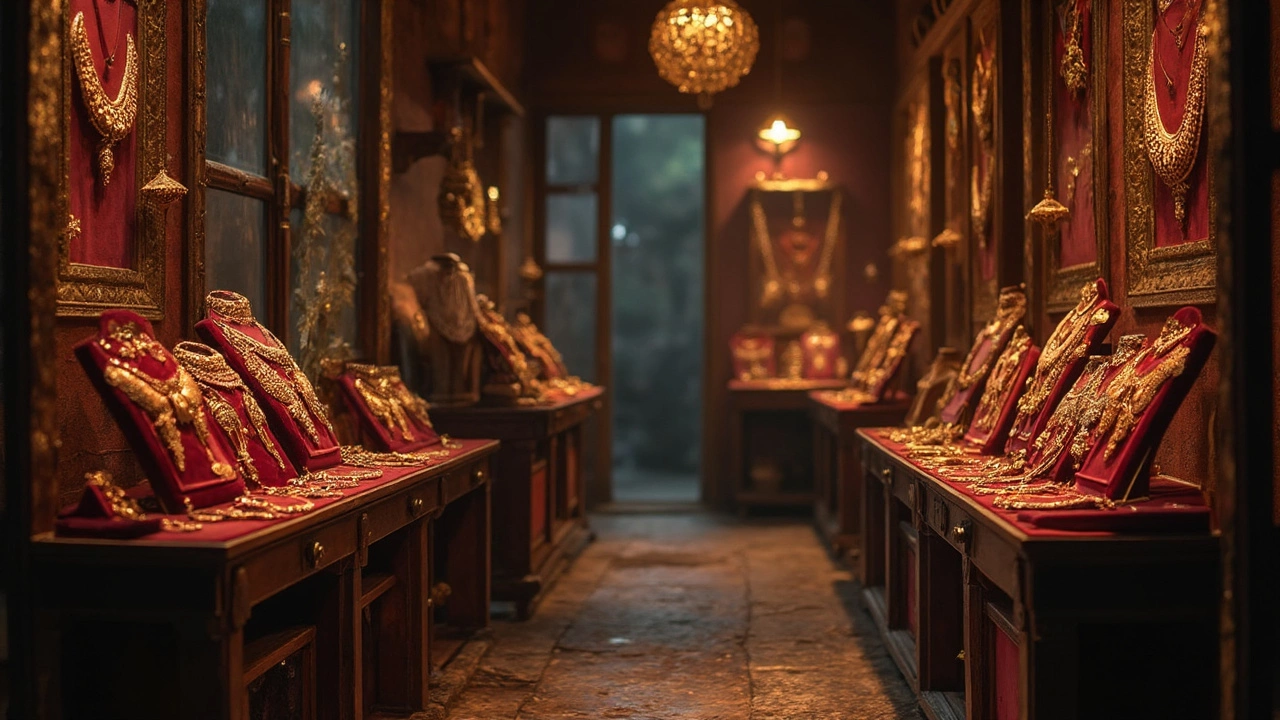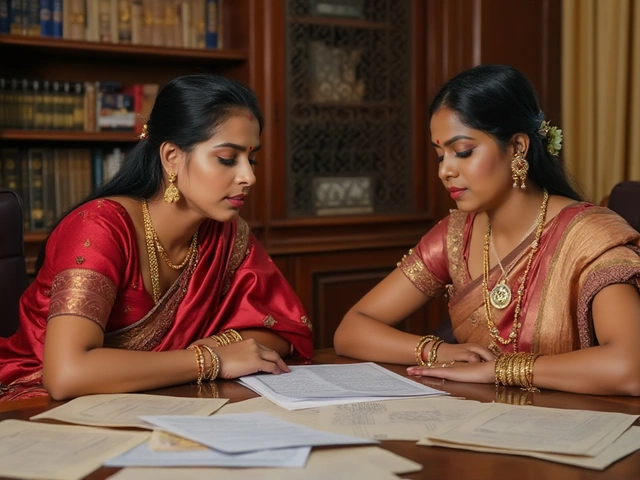Curious about what technically makes a piece of jewelry antique? You're definitely not alone. Generally, the term 'antique' is reserved for pieces that are at least 100 years old. So, if you're eyeing a beautiful Edwardian pendant from 1915, congratulations—it's a bona fide antique! This magical 100-year threshold helps collectors and enthusiasts distinguish true antiques from their slightly younger siblings, vintage pieces.
But the age alone doesn't tell the whole story. Recognizing an antique involves understanding the designs, materials, and even the history behind the piece. For example, Georgian jewelry, popular in the 18th century, often features intricate designs and gemstones like garnets and topaz. On the other hand, Art Nouveau styles from the early 1900s might showcase floral motifs and enamel. So, diving into these details not only enriches your knowledge but also heightens your appreciation of these irreplaceable pieces.
If you're thinking of investing in or simply appreciating antique jewelry, it's useful to learn how to spot the authentic ones. Doing some homework on the styles of different eras is a good start. Familiarizing yourself with common materials used for settings and stones will also help you discern genuine antiques. Plus, you'll gain insights into the artistry that went into creating them, making each piece feel like a mini-history lesson you can wear!
- Defining Antique Jewelry
- The 100-Year Rule
- Antique vs. Vintage
- Identifying Authentic Pieces
- Historical Styles and Materials
- Care Tips for Antique Jewelry
Defining Antique Jewelry
So, what exactly is antique jewelry? It might sound obvious, but there's more to it than just age. For a piece to earn the title 'antique,' the general rule is that it has to be at least 100 years old. This means anything crafted before 1925 qualifies as antique today. It's like a secret threshold where history and style meet.
However, being old isn't enough. Antiques often have rich stories embedded in their designs, reflecting the society and culture they came from. For instance, pieces from the Victorian era are celebrated for their romantic and elaborate designs, often featuring symbolic themes like lockets with secret compartments.
Distinguishing Periods and Eras
It's helpful to know the different periods when identifying antique jewelry. Here are some hallmark eras:
- Georgian Era (1714-1837): Known for intricate handcrafting, pieces from this time are quite rare due to their age.
- Victorian Era (1837-1901): Jewelry during this period was diverse, ranging from the bright and bold to the somber and discreet, especially after Prince Albert's death, when mourning jewelry became popular.
- Edwardian Era (1901-1910): Favored delicate filigree work and the use of diamonds and platinum.
- Art Nouveau (1890-1910): This style embraced nature, featuring flowing lines and organic shapes.
In contrast, vintage jewelry covers a wider timeline, including pieces that are at least 20 years old, but not quite hitting the century mark yet. This adds a layer to the antique-vintage distinction that both collectors and newcomers need to grasp.
Understanding these nuances not only deepens your appreciation but also helps you identify, purchase, or sell antique jewelry with confidence. Knowing the details of each era can be a game-changer in spotting authentic and valuable antiques.
The 100-Year Rule
So, what’s with the magic number 100 when it comes to antique jewelry? Well, it’s more than just a nice round number. By definition, for a piece of jewelry to be classified as antique, it needs to be at least a century old. This distinction helps us separate true antiques from later pieces like vintage jewelry, which typically hails from 20 to 99 years ago.
Why 100 years, you ask? It’s a benchmark that offers enough historical distance to ensure the design, craftsmanship, and materials used become representative of that specific era. Think of it as a stamp of historical significance that adds mystique and value.
History at a Glance
When evaluating a piece's age, you can often tell by its style, the materials, and sometimes even the maker’s marks. Each era has its defining characteristics. For instance:
- Georgian Era (1714-1837): Known for its bold designs and the use of colorful gemstones.
- Victorian Era (1837-1901): Split into Romantic, Grand, and Aesthetic periods, with sentimental motifs being very popular.
- Edwardian Era (1901-1915): Features elegant designs, often using platinum and diamonds.
Spotting an Antique
Authenticating antique jewelry isn’t always straightforward, but here are some tips to guide you:
- Look for hallmark stamps that indicate maker and purity.
- Examine the craftsmanship—older jewelry often shows handcraftsmanship marks.
- Identify the materials—older pieces might contain materials not used today, like gutta-percha or even tortoiseshell.
This 100-year threshold not only helps in categorizing jewelry but also plays a role in determining its value, both monetary and sentimental. After all, each antique piece is a tangible piece of history you can wear and treasure.
Antique vs. Vintage
If you've been collecting or even browsing for old jewelry, you've likely heard the terms antique jewelry and vintage being tossed around. But what do they really mean? Let's clear up any confusion because, believe it or not, these terms aren't just marketing buzzwords—they actually mean something!
Antique pieces, as we've mentioned, need to hit that 100-year mark. They're like the great-great-grandparents of modern jewels, carrying tales from yesteryears. If you're wearing an antique necklace, you're basically holding a piece of history around your neck.
Now, vintage jewelry is where it gets a bit flexible. Anything that's around 20 to 99 years old can comfortably fit into the vintage category. So, yes, your mom's necklace from the '80s? It's vintage now. Crazy, right? This category often includes pieces from well-loved eras like the iconic Victorian period and the playful Art Deco era.
Spotting the Difference
Distinguishing antique jewelry from vintage might seem tricky at first, but it's all about the details. Older pieces often show signs of the hands-on craftsmanship typical of their time. Plus, antique items may have more tarnishing or patina, which are basically beauty marks of history!
- Craftsmanship: Antique pieces usually showcase higher levels of handcrafting.
- Patina: An antique will often have more visible oxidation and wear.
- Materials: It's common to see different gem cuts and settings that aren't used much today.
It's crucial to know these differences, especially when buying or collecting. Each piece, whether antique or vintage, brings its charm and story. Understanding what you're looking at not only adds value to your collection but also deepens your appreciation.

Identifying Authentic Pieces
So, you're ready to delve into the world of antique jewelry, but how can you tell if a piece is the real deal? Authenticity is crucial, not just for bragging rights but also for ensuring your investment holds its value. Here's how you can separate the treasure from the trash.
Know the Hallmarks
Hallmarks are like a jeweler's fingerprint—they give you insight into the piece's origins and material quality. Look for tiny stamps on hidden places like clasps or inside bands. These marks can reveal the metal's purity and even the country and year of manufacture. A magnifying glass can be a handy tool here, especially when dealing with older, worn-down marks.
Investigate Provenance
This is just a fancy word for the piece's backstory. A documented history or even a tale from the seller can add to its authenticity. Items with a clear lineage from previous owners, especially those who’ve held onto them for decades, are more likely to be genuine.
Material Check
True antique jewelry often involves specific materials native or popular during a certain era. For example, Georgian pieces might feature 18K gold, while Victorian-era items could showcase chrysoberyl or rose-cut diamonds. Modern reproductions might skimp on quality or type of materials, so knowing what stones and metals to expect can save you from a bad buy.
Stylistic Consistency
Each period has its unique style. Georgian jewelry boasts elaborate metalwork and monochrome gemstones, while Art Deco pieces are celebrated for bold geometric shapes and flashy stones. Identifying these characteristics can be a dead giveaway of authenticity. If the style or execution feels off, it probably is.
Consult an Expert
When in doubt, it never hurts to get a second opinion. Consult with a certified appraiser or someone specializing in antique jewelry. They can offer insights that your untrained eye might miss, provide a proper valuation, and verify authenticity.
Red Flags to Watch Out For
- Unrealistic pricing or exceptional rarity claims without backup.
- Absence of hallmarks or dubious mark placements.
- Poor craftsmanship, especially in prongs or settings.
Buying antique jewelry can be as rewarding as it is thrilling. Equip yourself with the right knowledge, and you'll have a better chance of adding a genuine slice of history to your collection.
Historical Styles and Materials
When it comes to antique jewelry, the materials and styles tell all. Each era had its own flair, using different techniques and materials that reflected the times. Let's start with the Georgian era, which spans from 1714 to 1830. This period is known for its elaborate settings and handmade details, often featuring stones like garnets, turquoise, and topaz. Silver and gold were the metals of choice, but the designs were all about romanticism.
Victorian Era: Sentiment and Symbolism
The Victorian era (1837-1901) brought with it new materials and techniques. Queen Victoria’s taste for jewelry dramatically influenced the style of the period. This era is divided into three phases: Romantic, Mid-Victorian (or Grand), and Late Victorian (or Aesthetic). In the Romantic period, elaborate designs with gemstones such as amethysts and topaz were popular. In the Mid-Victorian phase, somber black jewelry, often made of jet or onyx, rose in popularity due to the Queen's mourning for Prince Albert. By the Late Victorian era, light and airy designs using diamonds and sapphires came into vogue.
Art Nouveau: Nature and Beauty
From 1890 to 1910, the Art Nouveau movement shifted focus to nature-inspired designs. This style featured flowing lines and organic shapes, often using enamel to create colorful masterpieces. The materials were more diverse, with a mix of opals, pearls, and moonstones, artistically set in metal backdrops like gold and silver.
Art Deco: Glamour and Geometry
The Art Deco period of the 1920s and 1930s embraced geometric patterns and bold designs. This era's jewelry often used white metals like platinum and white gold, which showed off the sparkle of diamonds and rubies beautifully. The craftsmanship was impeccable, with clean lines and symmetry being key.
The materials and designs from these times not only showcase the skill of the jewelers but also reflect societal changes and fashion trends. If you're interested in collecting or investing in antique jewelry, knowing these historical styles and the nuances in their materials can help guide you in spotting and appreciating authentic pieces that have stood the test of time.
Care Tips for Antique Jewelry
Got some antique jewelry and wondering how to keep it looking stunning? You're in the right place. Taking care of these treasured pieces isn't just about polishing them every now and then. It's about preserving their history and integrity.
Handle with Care
This one might seem obvious, but it's crucial. When handling your antique jewelry, always make sure your hands are clean and dry. Oils and dirt can tarnish the piece over time, and most antiques are delicate. So, whether you're putting on a necklace or taking off a ring, a gentle touch is key.
Storage Solutions
Where you store your jewelry makes a big difference. Use a soft-lined jewelry box or individual pouches to prevent scratches. Avoid extremes in temperature and humidity, as these can cause metals and stones to expand or contract, which might result in cracks or loosening.
- Separate pieces to prevent entanglement and scratches.
- Use anti-tarnish strips to protect against discoloration.
- For delicate pieces, consider a hard case for extra protection.
Cleaning Basics
Every piece of jewelry has its cleaning needs, especially antiques. Use a soft brush and mildly soapy water to gently clean them. Avoid submerging pieces in water for long periods and skip the ultrasonic cleaners, as they can do more harm than good.
- Mix a few drops of mild dish soap in lukewarm water.
- Dip a soft toothbrush into the mixture and gently scrub the jewelry.
- Rinse the piece with lukewarm water and pat dry with a soft cloth.
Don't forget to check if any stones or clasps are loose while cleaning. It's better to notice issues early before they become bigger problems.
Regular Check-ups
Just like regular doctor visits, your jewelry benefits from professional check-ups. Visit a trusted jeweler once a year to ensure settings are secure and stones are in place. It's the best way to catch problems before they cost you a part of your precious collection.
With some care and attention, your antique pieces will not only look amazing but they'll also stand the test of time — just like they've done for the past 100 years.



